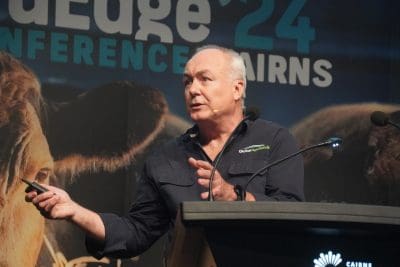THE United States live cattle futures market has been heavily spooked by developments in the spread of an infectious form of Avian Influenza (bird flu), firstly into US dairy cattle, and in the past week, from dairy animals into humans.

Simon Quilty addressing the AWA annual conference
Independent meat and livestock market analyst Simon Quilty opened his presentation during this afternoon’s Australian Wagyu Association annual conference in Cairns with a summary of recent developments, which he described as ‘somewhat extraordinary.’
Beef Central first wrote about the recent migration of the HPAI virus from birds into dairy cattle, and from there into humans, in this article last week.
Dairy cattle in three US states were found to be infected with the disease for the first time a fortnight ago, starting in Texas, and by today, six US states had reported cases in dairy animals. No signs of the disease have yet been found in US beef herds, but biosecurity measures had been implemented in some US states, Mr Quilty said .
“The reaction in the market saw US Live Cattle Futures last Monday and Tuesday fall for two success days by the limit – down US$14 per hundredweight. It is truly concerning,” Mr Quilty said.
As of earlier today, the disease had been given a new title – Bovine Influenza A virus.
“This is not a virus that is specific to birds, spreading to cattle by chance. Now, the findings in recent days are that it is being spread from cattle to cattle. Once that happens, it becomes a new virus, hence the new name,” Mr Quilty said.
The disease was originally found in migratory water fowl, with flight paths across north America making it impossible to stop.
Mr Quilty said it had been estimated that in those dairy herds that had contracted it, ten percent of animals were affected – but there had been no cattle deaths whatsoever.
“It’s the older cows that are being infected, with symptoms including reduced milk production and feed intake.”
In recent times, the virus had been transmitted into various feline (cat) species, bears, skunks and other mammals – in total 23 species.
“To me, this is a really important potential disruptor to local markets. The best we can say is the problem is one to watch. The Centre of Disease Control in North America is playing a crucial role in managing the issue – because now two people have acquired the virus (at least one via infected dairy animals).”
Symptoms in humans have been mild, mostly conjunctivitis of the eyes.
“But our concern, as an industry is obvious,” Mr Quilty said.
“If this gets blown out of proportion in the US media, it could lead to consumers reducing their intake of both milk, and beef.”
“Again, it is important to note that to date, the virus has not been found in the US beef herd. But for what it’s worth, the impact of the avian influenza in the poultry industry saw 50 million chickens culled in the US, and in Europe, 40 million.”
There had been no cases of avian influenza found in Australia, in any species. For that reason Australia would be regarded as low-risk, Mr Quilty said.
“For what it’s worth, about US$750 million worth of dairy products are exported by the US into China each year. This is important, because China is probably the one market that warrants concern. China can be reactionary to such situations.”
He said there had been no export bans placed on US dairy or beef products so far.



It may be time that these knee jerk reactions are tempered with some real science and not simply “he said, she said” comments. In my opinion, the CDC is well known around the world as a very unscientific organisation that is driven by political motives and corporate profits. We need independent scientists and nutritionists assessing these viral outbreaks to ensure there is no other toxin or nutritional problems causing the sickness. Our industries produce the safest food in the world and deserve real ethical scientists assessing the potential of any and every sickness, viral, chemical toxin, radiation and other pathogen.